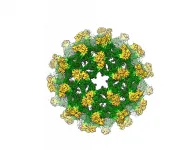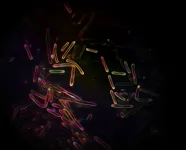New research shows: Antoni van Leeuwenhoek led rivals astray
2021-05-14
(Press-News.org) A microscope used by Antoni van Leeuwenhoek to conduct pioneering research contains a surprisingly ordinary lens, as new research by Rijksmuseum Boerhaave Leiden and TU Delft shows. It is a remarkable finding, because Van Leeuwenhoek (1632-1723) led other scientists to believe that his instruments were exceptional. Consequently, there has been speculation about his method for making lenses for more than three centuries. The results of this study were published in Science Advances on May 14.
Previous research carried out in 2018 already indicated that some of Van Leeuwenhoek's microscopes contained common ground lenses. Researchers have now examined a particularly highly magnifying specimen, from the collection of the University Museum Utrecht. Although it did contain a different type of lens, the great surprise was that the lens-making method used was a common one.
Pioneering but secretive
With his microscopes, Antoni van Leeuwenhoek saw a whole new world full of minute life which nobody had ever suspected could exist. He was the first to observe unicellular organisms, which is why he is called the father of microbiology. The detail of his observations was unprecedented and was only superseded over a century after his death.
His contemporaries were very curious about the lenses with which Van Leeuwenhoek managed to achieve such astounding feats. Van Leeuwenhoek, however, was very secretive about it, suggesting he had found a new way of making lenses. It now proves to have been an empty boast, at least as far as the Utrecht lens is concerned. This became clear when the researchers from Rijksmuseum Boerhaave Leiden and TU Delft subjected the Utrecht microscope to neutron tomography. It enabled them to examine the lens without opening the valuable microscope and destroy it in the process. The instrument was placed in a neutron beam at the Reactor Institute Delft, yielding a three-dimensional image of the lens.
Small globule
This lens turned out to be a small globule, and its appearance was consistent with a known production method used in Van Leeuwenhoek's time. The lens was very probably made by holding a thin glass rod in the fire, so that the end curled up into a small ball, which was then broken off the glass rod.
This method was described in 1678 by another influential microscopist, the Englishman Robert Hooke, which inspired other scientists to do the same. Van Leeuwenhoek, too, may have taken his lead from Hooke. The new discovery is ironical, because it was in fact Hooke who was very curious to learn more about Van Leeuwenhoek's 'secret' method.
The new study shows that Van Leeuwenhoek obtained extraordinary results with strikingly ordinary lens production methods.
INFORMATION:
[Attachments] See images for this press release:

ELSE PRESS RELEASES FROM THIS DATE:
2021-05-14
In research made possible when COVID-19 sidelined other research projects, scientists at Johns Hopkins Medicine meticulously counted brain cells in fruit flies and three species of mosquitos, revealing a number that would surprise many people outside the science world.
The insects' tiny brains, on average, have about 200,000 neurons and other cells, they say. By comparison, a human brain has 86 billion neurons, and a rodent brain contains about 12 billion. The figure probably represents a "floor" for the number needed to perform the bugs' complex behaviors.
"Even though these brains are simple [in contrast to mammalian brains], they can do a lot of processing, even more than a supercomputer," says Christopher Potter, Ph.D., associate professor of neuroscience ...
2021-05-14
Being treated fairly is important - but fairness alone isn't enough to make people feel valued in a workplace or other groups, new research suggests.
Researchers found that "distinctive treatment" - where a person's talents and qualities are recognised - provides this sense of value while also reinforcing their sense of inclusion. It also promotes mental health.
The findings suggest there is no conflict between "fitting in" and "standing out" in groups - in fact, they complement each other.
But while the importance of fairness is widely accepted, the researchers say distinctive treatment is ...
2021-05-14
AMES, Iowa - The field photos show the hard, rough country that some glaciers slide over: rocky domes and bumps in granite, rocky steps and depressions in limestone. The glacier beds dwarf the researchers and their instruments. (As do the high mountains pictured on the various horizons.)
During their trips to glacier beds recently exposed by retreating glaciers in the Swiss Alps (Rhone, Schwarzburg and Tsanfleuron glaciers) and the Canadian Rockies (Castleguard Glacier), four glaciologists used laser and drone technology to precisely measure the rocky beds and record their very different contours.
The researchers turned the measurements into high-resolution digital models of those glacier beds. Then they went to work with manageable but representative subunits of the ...
2021-05-14
Better designed vaccines for insect-spread viruses like dengue and Zika are likely after researchers discovered models of immature flavivirus particles were originally misinterpreted.
Researchers from The University of Queensland and Monash University have now determined the first complete 3D molecular structure of the immature flavivirus, revealing an unexpected organisation.
UQ researcher Associate Professor Daniel Watterson said the team was studying the insect-specific Binjari virus when they made the discovery.
"We were using Australia's safe-to-handle Binjari virus, which we combine with more dangerous viral genes to make safer and more effective vaccines," Dr Watterson ...
2021-05-14
ITHACA, NY, May 13, 2021 -- Cyanobacteria are one of the unsung heroes of life on Earth. They first evolved to perform photosynthesis about 2.4 billion years ago, pumping tons of oxygen into the atmosphere - a period known as the Great Oxygenation Event - which enabled the evolution of multicellular life forms.
Led by BTI faculty member END ...
2021-05-14
The United States has witnessed a steep rise in reports, arrests, and media coverage of teachers' sexual misconduct with students. A new study investigated the impact of perpetrators' gender, sexuality, and age on perceptions of teacher sexual misconduct. The study found that
responses to teachers' misconduct varied according to certain characteristics, which can influence whether victims report the misconduct.
The study, by researchers at Prairie View A&M University and the University of Nevada, Reno, appears in Feminist Criminology.
"Because sexual abuse of a child or adolescent in any context has substantial psychological, emotional, and physical consequences for the victim, teachers' sexual misconduct is a serious public health ...
2021-05-14
Developing self-healing materials is nothing new for Nancy Sottos, lead of the Autonomous Materials Systems Group at the END ...
2021-05-14
Three billion years ago, light first zipped through chlorophyll within tiny reaction centers, the first step plants and photosynthetic bacteria take to convert light into food.
Heliobacteria, a type of bacteria that uses photosynthesis to generate energy, has reaction centers thought to be similar to those of the common ancestors for all photosynthetic organisms. Now, a University of Michigan team has determined the first steps in converting light into energy for this bacterium.
"Our study highlights the different ways in which nature has made use of the basic reaction ...
2021-05-14
May 14, 2021 - Two thirds of all pediatric spinal fractures, especially in the adolescent population, occur in motor vehicle accidents (MVAs) where seatbelts are not utilized, reports a study in Spine. The journal is published in the Lippincott portfolio by Wolters Kluwer.
"Over 60 percent of pediatric spinal fractures occur in children ages 15 to 17, coinciding with the beginning of legal driving," according to the new research by Dr. Vishal Sarwahi, MD, of Cohen Children's Medical Center, New Hyde Park, NY, and colleagues. They emphasize the need for measures to increase seatbelt usage, particularly by younger drivers, and outline the potential trauma that can be avoided through proper seatbelt use.
Seatbelts save lives... and ...
2021-05-14
May 14, 2021 - Two years ago, the Veterans Affairs healthcare system (VA) began rolling out a new benefit, enabling Veterans to receive urgent care from a network of community providers - rather than visiting a VA emergency department or clinic. Progress toward expanding community care services for Veterans is the focus of a special supplement to the May issue of Medical Care. The journal is published in the Lippincott portfolio by Wolters Kluwer.
The urgent care benefit "provides a new way to deliver unscheduled, low-acuity acute care to Veterans," according to the ...
LAST 30 PRESS RELEASES:
[Press-News.org] New research shows: Antoni van Leeuwenhoek led rivals astray




